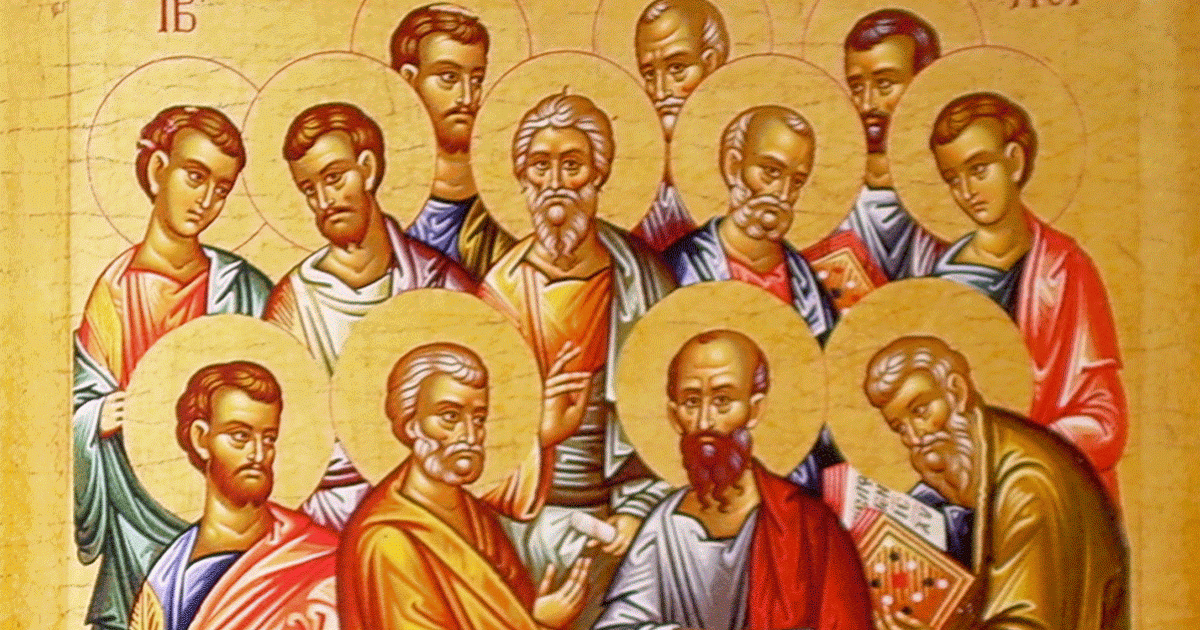During the third stanza of the Lamentations, the above hymn is sung, (Eranan ton Tafo in Greek) during which the priest will sprinkle fragrant rose water over the church and the congregation. In many parishes, young girls also stand around the tomb of Christ and during this hymn throw rose petals onto the tomb. Both of these actions commemorate the work of those who buried the Lord, according to Jewish custom, with fragrant spices. We’ve already met the two men who participated in the burial of Christ—Joseph of Arimathea and Nicodemus—and today we will reflect on the women who were also present and participating. They are known as the myrrh-bearing women.
There are either seven or eight myrrh-bearing women, depending on if the Virgin Mary is counted as one of them. In either case, it is the Virgin Mary plus seven others who were devout followers of Jesus during his three-year ministry and who ministered to Him in death. They are identified as Mary Magdalene, Joanna, Salome, Mary the wife of Cleopas, Susanna, and the sisters Mary and Martha, and of course the Virgin Mary.
In Luke 8:1-3 we read,
Soon afterward He went on through cities and villages, preaching and bringing the good news of the kingdom of God. And the twelve were with Him, and also some women who had been healed of evil spirits and infirmities: Mary, called Magdalene, from whom seven demons had gone out, and Joanna, the wife of Chuza, Herod’s steward, and Susanna, and many others, who provided for them out of their means.
These three women are identified early on in Luke’s Gospel. They were also women of means, who helped provide for Christ’s ministry from their wealth.
In Matthew 27:55-56, we read that Mary Magdalene and Mary the mother of James and Joseph (that is the Virgin Mary) and the mother of the sons of Zebedee were at the foot of the cross.
Mark 15:40 identifies Mary Magdalene, Mary the mother of James the younger and Joses (the Virgin Mary) and Salome as being at the foot of the cross.
John 19:25 identifies the Virgin Mary, Mary the wife of Clopas, and Mary Magdelene as being at the foot of the cross.
In Matthew 27:56 and 28:1, we read about “Mary Magdalene and the other Mary” who were sitting opposite the sepulcher on Friday evening, and who went to the tomb very early after the Sabbath had passed. The “other Mary” is thought to be the Virgin Mary.
Despite the slight variations in the Gospel accounts, a few things are very certain. First, Jesus had devout followers who were women. We read a lot about the twelve Disciples, and many think because the women aren’t mentioned as much, that Jesus didn’t have women followers in His inner circle. Obviously, that is not true.
Second, these women showed great courage staying at the crucifixion. All the disciples fled, except for John, and it was these women who had the courage to stand at the cross with Jesus, to care for Him at the time of His burial, and who went to the tomb after the Sabbath had passed and found it empty. They were the first to proclaim the good news by telling it to the other disciples. Any follower of Jesus risked their own death, by crucifixion nonetheless. These women standing so loyally and lovingly at the foot of the cross and near the tomb was nothing less than risking their own lives, a commendable and inspiring expression of faith.
Women have played a prominent role in both the ministry of Christ and in the life of the church since the time of Christ. While it seems to be more men that get recognized—twelve disciples, Bishops, Ascetic Fathers, etc.—the role of women has been significant. In fact, several women saints, like St. Olga, St. Helen, St. Photini (the Samaritan woman at the well), St. Thekla, and St. Mary Magdalene have been given the title “equal to the Apostles” because of their work in spreading the Gospel had a similar weight to the work of the original Apostles.
It is interesting to note that the only reference to the disciples in the Lamentations is one reference to John, the rest to Judas. The myrrh-bearing women are mentioned several times.
O Lord my God, I shall sing You a funeral hymn and a burial ode; for through Your Burial You opened for me the portals of life; and by death You have put Death and Hades to death. (Ode One of the Canon, Lamentations, Good Friday evening, Tran. By Fr. George Papadeas)
In reflecting on all the important people of the Holy Week story, the myrrh-bearing women figure very prominently for their love, loyalty, and courage, three attributes we should all be cultivating in our relationship with Christ.


0 Comments